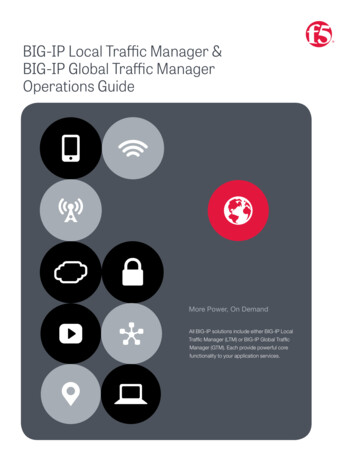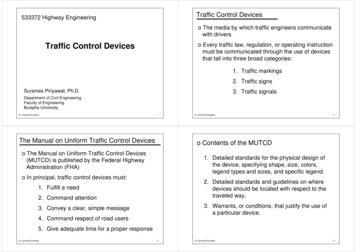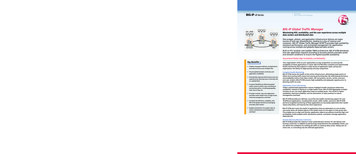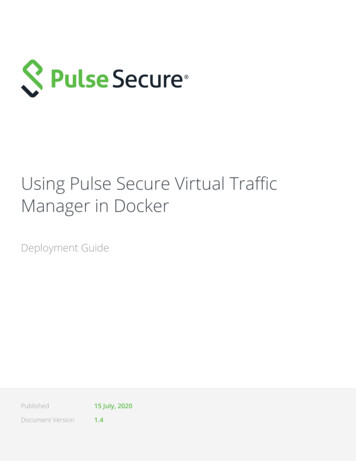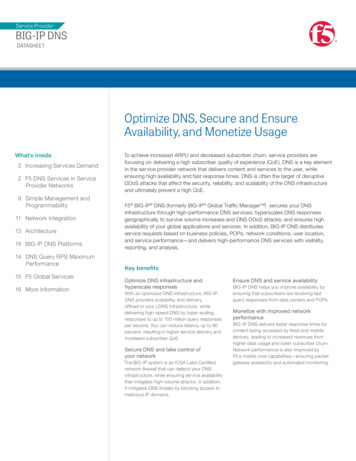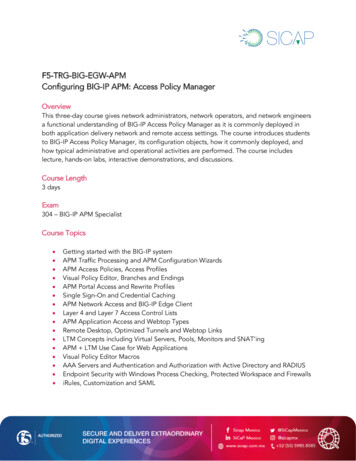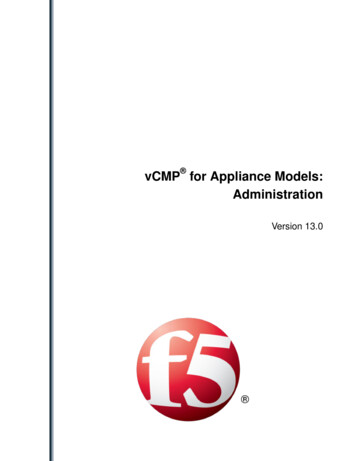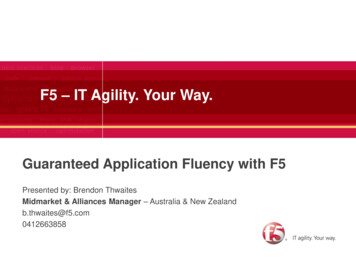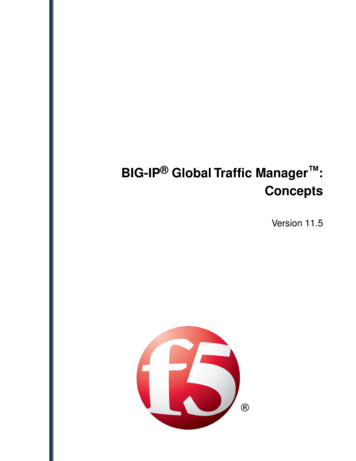
Transcription
BIG-IP Global Traffic Manager :ConceptsVersion 11.5
Table of ContentsTable of ContentsLegal Notices.7Acknowledgments.9Chapter 1: About Global Server Load Balancing.13Introducing the Global Traffic Manager.14About global server load balancing.14Static load balancing methods.14Dynamic load balancing methods.16About load balancing and resource availability.17About virtual server dependency.18Configuring virtual server availability to be dependent on the status of othervirtual servers.18Limit settings for resource availability.18About wide IP-level load balancing.19About the Global Availability load balancing method.19About the Ratio load balancing method.19About the Round Robin load balancing method.20About Topology load balancing.21About pool-level load balancing.21About the Drop Packet load balancing method.21About the Virtual Server Score load balancing method.21About the Virtual Server Capacity load balancing method.22About the Round Trip Times load balancing method.22About the Packet Rate load balancing method.22About the Least Connections load balancing method.22About the Kilobyte/Second load balancing method.22About the Hops load balancing method.22About the Completion Rate load balancing method.23About the CPU load balancing method.23About the Return to DNS load balancing method.23About Static Persist load balancing.23About the Fallback IP load balancing method.23About the None load balancing method.24About the QoS load balancing method.24About dynamic ratio load balancing.26Using the preferred load balancing method when metrics are unavailable.27Configuring the resources in a pool for manual resume.27Restoring availability of a pool member manually.28Chapter 2: Communications Between BIG-IP GTM and Other Systems.293
Table of ContentsAbout establishing communications between GTM and other systems.30About iQuery.30About iQuery and communications between BIG-IP systems.30Viewing iQuery statistics .31About the gtm add script.31About the big3d install script.32About the bigip add script.32Chapter 3: Configuration Synchronization.33About configuration synchronization.34About NTP servers and GTM configuration synchronization.34Chapter 4: BIG-IP GTM Configuration.35About listeners.36How listeners process network traffic.36About wildcard listeners.37About Prober pools.37About Prober pool statistics.38About Prober pool status.38About probes.38About GTM probes of an LDNS.38Converting a statistics collection server to a Prober pool automatically.39About delegation of LDNS probes.40About LDNS entries on a GTM.40Protocols and ports used by big3d during communications with local DNSservers.40About wide IPs.41About wildcard characters in wide IP names.41About persistence connections.42About wide IPs and a last resort pool.43About data centers.44About servers.44About third-party host servers.44About third-party load balancing servers.45About virtual servers.45About pools and pool members.46About CNAME records.46About links.46Defining a link.47Load balancing outbound traffic through links of differing bandwidths.47Load balancing outbound traffic over the least expensive link first.48Configuring statistics to reflect link bandwidth usage.49About distributed applications.50About ZoneRunner.504
Table of ContentsAbout named.conf.50Creating a master DNS zone.51Creating a hint zone.51Configuring GTM to allow zone file transfers.52About DNS views.53Types of DNS zone files.54Types of DNS resource records.55About DNSSEC.56About DNSSEC keys.56About enhancing DNSSEC key security.56Viewing DNSSEC records in ZoneRunner.57Protocols supported by the BIG-IP system.575
Table of Contents6
Legal NoticesPublication DateThis document was published on January 27, 2014.Publication NumberMAN-0346-05CopyrightCopyright 2013-2014, F5 Networks, Inc. All rights reserved.F5 Networks, Inc. (F5) believes the information it furnishes to be accurate and reliable. However, F5 assumesno responsibility for the use of this information, nor any infringement of patents or other rights of thirdparties which may result from its use. No license is granted by implication or otherwise under any patent,copyright, or other intellectual property right of F5 except as specifically described by applicable userlicenses. F5 reserves the right to change specifications at any time without notice.TrademarksAAM, Access Policy Manager, Advanced Client Authentication, Advanced Firewall Manager, AdvancedRouting, AFM, APM, Application Acceleration Manager, Application Security Manager, ARX, AskF5,ASM, BIG-IP, BIG-IQ, Cloud Extender, CloudFucious, Cloud Manager, Clustered Multiprocessing, CMP,COHESION, Data Manager, DevCentral, DevCentral [DESIGN], DNS Express, DSC, DSI, Edge Client,Edge Gateway, Edge Portal, ELEVATE, EM, Enterprise Manager, ENGAGE, F5, F5 [DESIGN], F5 Certified[DESIGN], F5 Networks, F5 SalesXchange [DESIGN], F5 Synthesis, f5 Synthesis, F5 Synthesis [DESIGN],F5 TechXchange [DESIGN], Fast Application Proxy, Fast Cache, FirePass, Global Traffic Manager, GTM,GUARDIAN, iApps, IBR, Intelligent Browser Referencing, Intelligent Compression, IPv6 Gateway,iControl, iHealth, iQuery, iRules, iRules OnDemand, iSession, L7 Rate Shaping, LC, Link Controller, LocalTraffic Manager, LTM, LineRate, LineRate Systems [DESIGN], LROS, LTM, Message Security Manager,MSM, OneConnect, Packet Velocity, PEM, Policy Enforcement Manager, Protocol Security Manager,PSM, Real Traffic Policy Builder, SalesXchange, ScaleN, Signalling Delivery Controller, SDC, SSLAcceleration, software designed applications services, SDAC (except in Japan), StrongBox, SuperVIP,SYN Check, TCP Express, TDR, TechXchange, TMOS, TotALL, Traffic Management Operating System,Traffix Systems, Traffix Systems (DESIGN), Transparent Data Reduction, UNITY, VAULT, vCMP, VEF5 [DESIGN], Versafe, Versafe [DESIGN], VIPRION, Virtual Clustered Multiprocessing, WebSafe, andZoneRunner, are trademarks or service marks of F5 Networks, Inc., in the U.S. and other countries, andmay not be used without F5's express written consent.All other product and company names herein may be trademarks of their respective owners.PatentsThis product may be protected by one or more patents indicated entsExport Regulation NoticeThis product may include cryptographic software. Under the Export Administration Act, the United Statesgovernment may consider it a criminal offense to export this product from the United States.
Legal NoticesRF Interference WarningThis is a Class A product. In a domestic environment this product may cause radio interference, in whichcase the user may be required to take adequate measures.FCC ComplianceThis equipment has been tested and found to comply with the limits for a Class A digital device pursuantto Part 15 of FCC rules. These limits are designed to provide reasonable protection against harmfulinterference when the equipment is operated in a commercial environment. This unit generates, uses, andcan radiate radio frequency energy and, if not installed and used in accordance with the instruction manual,may cause harmful interference to radio communications. Operation of this equipment in a residential areais likely to cause harmful interference, in which case the user, at his own expense, will be required to takewhatever measures may be required to correct the interference.Any modifications to this device, unless expressly approved by the manufacturer, can void the user's authorityto operate this equipment under part 15 of the FCC rules.Canadian Regulatory ComplianceThis Class A digital apparatus complies with Canadian ICES-003.Standards ComplianceThis product conforms to the IEC, European Union, ANSI/UL and Canadian CSA standards applicable toInformation Technology products at the time of manufacture.8
AcknowledgmentsThis product includes software developed by Gabriel Forté.This product includes software developed by Bill Paul.This product includes software developed by Jonathan Stone.This product includes software developed by Manuel Bouyer.This product includes software developed by Paul Richards.This product includes software developed by the NetBSD Foundation, Inc. and its contributors.This product includes software developed by the Politecnico di Torino, and its contributors.This product includes software developed by the Swedish Institute of Computer Science and its contributors.This product includes software developed by the University of California, Berkeley and its contributors.This product includes software developed by the Computer Systems Engineering Group at the LawrenceBerkeley Laboratory.This product includes software developed by Christopher G. Demetriou for the NetBSD Project.This product includes software developed by Adam Glass.This product includes software developed by Christian E. Hopps.This product includes software developed by Dean Huxley.This product includes software developed by John Kohl.This product includes software developed by Paul Kranenburg.This product includes software developed by Terrence R. Lambert.This product includes software developed by Philip A. Nelson.This product includes software developed by Herb Peyerl.This product includes software developed by Jochen Pohl for the NetBSD Project.This product includes software developed by Chris Provenzano.This product includes software developed by Theo de Raadt.This product includes software developed by David Muir Sharnoff.This product includes software developed by SigmaSoft, Th. Lockert.This product includes software developed for the NetBSD Project by Jason R. Thorpe.This product includes software developed by Jason R. Thorpe for And Communications, http://www.and.com.This product includes software developed for the NetBSD Project by Frank Van der Linden.This product includes software developed for the NetBSD Project by John M. Vinopal.This product includes software developed by Christos Zoulas.This product includes software developed by the University of Vermont and State Agricultural College andGarrett A. Wollman.This product includes software developed by Balazs Scheidler (bazsi@balabit.hu), which is protected underthe GNU Public License.
AcknowledgmentsThis product includes software developed by Niels Mueller (nisse@lysator.liu.se), which is protected underthe GNU Public License.In the following statement, This software refers to the Mitsumi CD-ROM driver: This software was developedby Holger Veit and Brian Moore for use with 386BSD and similar operating systems. Similar operatingsystems includes mainly non-profit oriented systems for research and education, including but not restrictedto NetBSD, FreeBSD, Mach (by CMU).This product includes software developed by the Apache Group for use in the Apache HTTP server project(http://www.apache.org/).This product includes software licensed from Richard H. Porter under the GNU Library General PublicLicense ( 1998, Red Hat Software), www.gnu.org/copyleft/lgpl.html.This product includes the standard version of Perl software licensed under the Perl Artistic License ( 1997,1998 Tom Christiansen and Nathan Torkington). All rights reserved. You may find the most current standardversion of Perl at http://www.perl.com.This product includes software developed by Jared Minch.This product includes software developed by the OpenSSL Project for use in the OpenSSL Toolkit(http://www.openssl.org/).This product includes cryptographic software written by Eric Young (eay@cryptsoft.com).This product contains software based on oprofile, which is protected under the GNU Public License.This product includes RRDtool software developed by Tobi Oetiker (http://www.rrdtool.com/index.html)and licensed under the GNU General Public License.This product contains software licensed from Dr. Brian Gladman under the GNU General Public License(GPL).This product includes software developed by the Apache Software Foundation (http://www.apache.org/).This product includes Hypersonic SQL.This product contains software developed by the Regents of the University of California, Sun Microsystems,Inc., Scriptics Corporation, and others.This product includes software developed by the Internet Software Consortium.This product includes software developed by Nominum, Inc. (http://www.nominum.com).This product contains software developed by Broadcom Corporation, which is protected under the GNUPublic License.This product contains software developed by MaxMind LLC, and is protected under the GNU Lesser GeneralPublic License, as published by the Free Software Foundation.This product includes unbound software from NLnetLabs. Copyright 2007. All rights reserved.Redistribution and use in source and binary forms, with or without modification, are permitted providedthat the following conditions are met: Redistributions of source code must retain the above copyright notice, this list of conditions and thefollowing disclaimer.Redistributions in binary form must reproduce the above copyright notice, this list of conditions and thefollowing disclaimer in the documentation and/or other materials provided with the distribution.Neither the name of NLnetLabs nor the names of its contributors may be used to endorse or promoteproducts derived from this software without specific prior written permission.THIS SOFTWARE IS PROVIDED BY THE COPYRIGHT HOLDERS AND CONTRIBUTORS "AS IS"AND ANY EXPRESS OR IMPLIED WARRANTIES, INCLUDING, BUT NOT LIMITED TO, THEIMPLIED WARRANTIES OF MERCHANTABILITY AND FITNESS FOR A PARTICULAR PURPOSEARE DISCLAIMED. IN NO EVENT SHALL THE COPYRIGHT OWNER OR CONTRIBUTORS BE10
BIG-IP Global Traffic Manager : ConceptsLIABLE FOR ANY DIRECT, INDIRECT, INCIDENTAL, SPECIAL, EXEMPLARY, ORCONSEQUENTIAL DAMAGES (INCLUDING, BUT NOT LIMITED TO, PROCUREMENT OFSUBSTITUTE GOODS OR SERVICES; LOSS OF USE, DATA, OR PROFITS; OR BUSINESSINTERRUPTION) HOWEVER CAUSED AND ON ANY THEORY OF LIABILITY, WHETHER INCONTRACT, STRICT LIABILITY, OR TORT (INCLUDING NEGLIGENCE OR OTHERWISE) ARISINGIN ANY WAY OUT OF THE USE OF THIS SOFTWARE, EVEN IF ADVISED OF THE POSSIBILITYOF SUCH DAMAGE.This product includes Intel QuickAssist kernel module, library, and headers software licensed under theGNU General Public License (GPL).This product includes software licensed from Gerald Combs (gerald@wireshark.org) under the GNU GeneralPublic License as published by the Free Software Foundation; either version 2 of the License, or any laterversion. Copyright 1998 Gerald Combs.This product includes software developed by Thomas Williams and Colin Kelley. Copyright 1986 - 1993,1998, 2004, 2007Permission to use, copy, and distribute this software and its documentation for any purpose with or withoutfee is hereby granted, provided that the above copyright notice appear in all copies and that both thatcopyright notice and this permission notice appear in supporting documentation. Permission to modify thesoftware is granted, but not the right to distribute the complete modified source code. Modifications are tobe distributed as patches to the released version. Permission to distribute binaries produced by compilingmodified sources is granted, provided you1. distribute the corresponding source modifications from the released version in the form of a patch filealong with the binaries,2. add special version identification to distinguish your version in addition to the base release versionnumber,3. provide your name and address as the primary contact for the support of your modified version, and4. retain our contact information in regard to use of the base software.Permission to distribute the released version of the source code along with corresponding source modificationsin the form of a patch file is granted with same provisions 2 through 4 for binary distributions. This softwareis provided "as is" without express or implied warranty to the extent permitted by applicable law.This product contains software developed by Google, Inc. Copyright 2011 Google, Inc.Permission is hereby granted, free of charge, to any person obtaining a copy of this software and associateddocumentation files (the "Software"), to deal in the Software without restriction, including without limitationthe rights to use, copy, modify, merge, publish, distribute, sublicense, and/or sell copies of the Software,and to permit persons to whom the Software is furnished to do so, subject to the following conditions:The above copyright notice and this permission notice shall be included in all copies or substantial portionsof the Software.THE SOFTWARE IS PROVIDED "AS IS", WITHOUT WARRANTY OF ANY KIND, EXPRESS ORIMPLIED, INCLUDING BUT NOT LIMITED TO THE WARRANTIES OF MERCHANTABILITY,FITNESS FOR A PARTICULAR PURPOSE AND NONINFRINGEMENT. IN NO EVENT SHALL THEAUTHORS OR COPYRIGHT HOLDERS BE LIABLE FOR ANY CLAIM, DAMAGES OR OTHERLIABILITY, WHETHER IN AN ACTION OF CONTRACT, TORT OR OTHERWISE, ARISING FROM,OUT OF OR IN CONNECTION WITH THE SOFTWARE OR THE USE OR OTHER DEALINGS INTHE SOFTWARE.This product includes software developed by Digital Envoy, Inc.This product includes software developed by Jeremy Ashkenas and DocumentCloud, and distributed underthe MIT license. Copyright 2010-2013 Jeremy Ashkenas, DocumentCloud.This product includes gson software, distributed under the Apache License version 2.0. Copyright 2008-2011 Google Inc.11
Chapter1About Global Server Load Balancing Introducing the Global Traffic ManagerAbout global server load balancingAbout load balancing and resourceavailabilityAbout wide IP-level load balancingAbout pool-level load balancing
About Global Server Load BalancingIntroducing the Global Traffic ManagerBIG-IP Global Traffic Manager (GTM ) is a system that monitors the availability and performance ofglobal resources and uses that information to manage network traffic patterns. BIG-IP GTM uses loadbalancing algorithms, topology-based routing, and iRules to control and distribute traffic according tospecific policies.About global server load balancingBIG-IP Global Traffic Manager (GTM ) provides tiered global server load balancing (GSLB). BIG-IPGTM distributes DNS name resolution requests, first to the best available pool in a wide IP, and then to thebest available virtual server within that pool. GTM selects the best available resource using either a staticor a dynamic load balancing method. Using a static load balancing method, BIG-IP GTM selects a resourcebased on a pre-defined pattern. Using a dynamic load balancing method, BIG-IP GTM selects a resourcebased on current performance metrics collected by the big3d agents running in each data center.Static load balancing methodsThis table describes the static load balancing methods available in BIG-IP Global Traffic Manager (GTM ).NameDescriptionRecommended Use Wide IP Preferred Alternate FallbackLoadMethod Method MethodBalancingDropPacketBIG-IP GTM drops the DNS request. Use Drop Packet forNothe Alternate loadbalancing method whenyou want to ensure thatGTM does not offer ina response a virtualserver that is potentiallyunavailable.YesYesYesFallback IP BIG-IP GTM distributes DNS nameresolution requests to a virtual serverthat you specify. This virtual serveris not monitored for availability.Use Fallback IP for the Nofallback load balancingmethod when you wantGTM to return a disasterrecovery site when thepreferred and alternateload balancing methodsdo not return anavailable virtual server.NoNoYesGlobalBIG-IP GTM distributes DNS nameAvailability resolution requests to the firstavailable virtual server in a pool.BIG-IP GTM starts at the top of amanually configured list of virtualservers and sends requests to the firstUse Global Availability Yeswhen you have specificvirtual servers that youwant to handle most ofthe requests.YesYesYes14
BIG-IP Global Traffic Manager : ConceptsNameDescriptionRecommended Use Wide IP Preferred Alternate FallbackLoadMethod Method MethodBalancingavailable virtual server in the list.Only when the virtual server becomesunavailable does BIG-IP GTM sendrequests to the next virtual server inthe list. Over time, the first virtualserver in the list receives the mostrequests and the last virtual server inthe list receives the least requests.NoneBIG-IP GTM distributes DNS nameresolution requests skipping either thenext available pool in a multiple poolconfiguration or the current loadbalancing method. If all pools areunavailable, BIG-IP GTM returns anaggregate of the IP addresses of allthe virtual servers in the pool usingBIND.Use None for theNoalternate and fallbackmethods when you wantto limit each pool to asingle load balancingmethod. If the preferredload balancing methodfails, GTM offers thenext pool in a loadbalancing response.NoYesYesRatioBIG-IP GTM distributes DNS nameresolution requests among the virtualservers in a pool or among pools in amultiple pool configuration usingweighted round robin, a loadbalancing pattern in which requestsare distributed among severalresources based on a priority level orweight assigned to each resource.Use Ratio when youwant to send twice asmany connections to afast server and half asmany connections to aslow server.YesYesYesYesReturn toDNSBIG-IP GTM immediately distributes Use Return to DNSNoDNS name resolution requests to an when you want toLDNS for resolution.temporarily remove apool from service. Youcan also use Return toDNS when you want tolimit a pool in a singlepool configuration toonly one or two loadbalancing attempts.YesYesYesRoundRobinBIG-IP GTM distributes DNS nameresolution requests in a circular andsequential pattern among the virtualservers in a pool. Over time eachvirtual server receives an equalnumber of requests.Use Round RobinYeswhen you want todistribute requestsequally among allvirtual servers in a pool.YesYesYesStaticPersistBIG-IP GTM distributes DNS nameresolution requests to the firstavailable virtual server in a pool usingthe persist mask with the source IPaddress of the LDNS and a hashalgorithm to determine the order ofthe virtual servers in the list. ThisUse Static Persist when Noyou want requests froma specific LDNS toresolve to a specificvirtual server.YesYesYes15
About Global Server Load BalancingNameDescriptionRecommended Use Wide IP Preferred Alternate FallbackLoadMethod Method MethodBalancinghash algorithm orders the virtualservers in the list differently for eachLDNS that is passing traffic to thesystem taking into account thespecified CIDR of the LDNS. EachLDNS (and thus each client)generally resolves to the same virtualserver; however, when the selectedvirtual server becomes unavailable,BIG-IP GTM sends requests toanother virtual server until theoriginal virtual server becomesavailable. Then BIG-IP GTM againresolves requests to that virtual server.TopologyBIG-IP GTM distributes DNS nameresolution requests usingproximity-based load balancing.BIG-IP GTM determines theproximity of the resource bycomparing location informationderived from the DNS message to thetopology records in a topologystatement you have configured.Use Topology whenYesyou want to sendrequests from a client ina particular geographicregion to a data centeror server located in thatregion.YesYesYesDynamic load balancing methodsThis table describes the dynamic load balancing methods available in BIG-IP Global Traffic Manager (GTM letion RateBIG-IP GTM distributes DNS name resolution Norequests to the virtual server that currentlymaintains the least number of dropped or timed-outpac
About Global Server Load Balancing Introducing the Global Traffic Manager About global server load balancing About load balancing and resource availability About wide IP-level load balancing About pool-level load balancing

